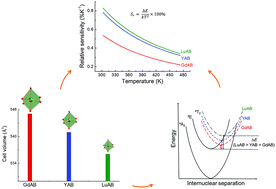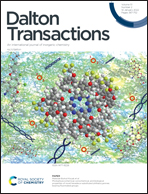Enhancing the temperature sensitivity of Cr3+ emissions by modification of the host's composition for fluorescence thermometry applications†
Abstract
The fluorescence intensity ratio (FIR) technique is widely adopted in thermometric phosphor materials, but the improvement of relative sensitivity is normally limited by the fixed energy gap between two thermally-coupled emitting levels of luminescent ions. Herein, LnAl3(BO3)4:Cr3+ (LnAB:Cr3+, Ln = Gd, Y, Lu) phosphors are found to simultaneously show 4T2 and 2E emissions of Cr3+, and their FIR is sensitive to temperature and suitable for fluorescence thermometric applications. Moreover, the energy gap between the 4T2 and 2E levels of Cr3+ is tunable and the relative sensitivity can be greatly improved by modifying the host's composition. Structural analysis and spectroscopic data confirm that the enhanced crystal-field of the Cr3+/Al3+ sites caused by incorporating smaller Ln3+ ions into the host contributes to the improvement of relative sensitivity. This work would provide new insights into the development of novel FIR thermometric materials with high-sensitivity.



 Please wait while we load your content...
Please wait while we load your content...